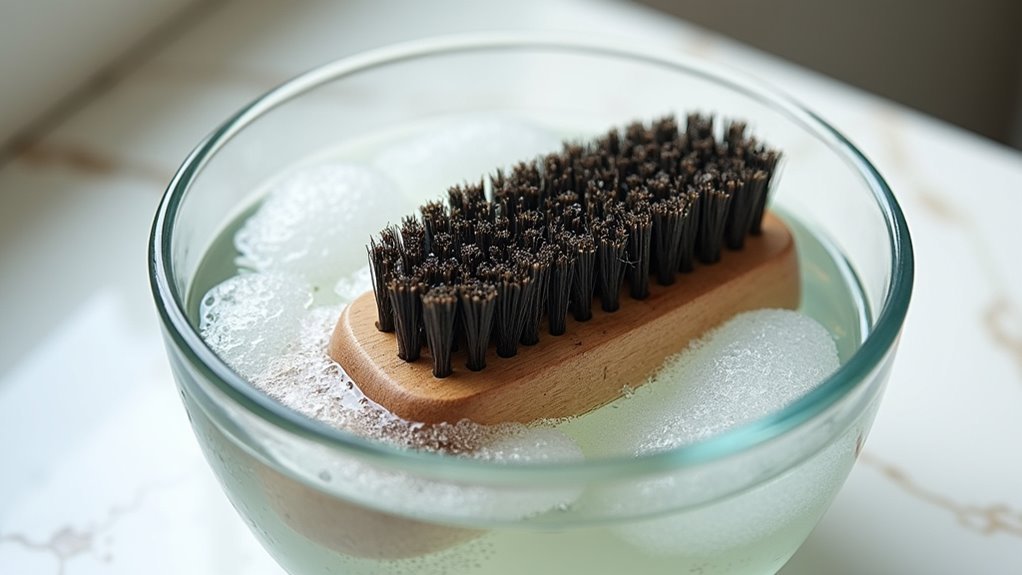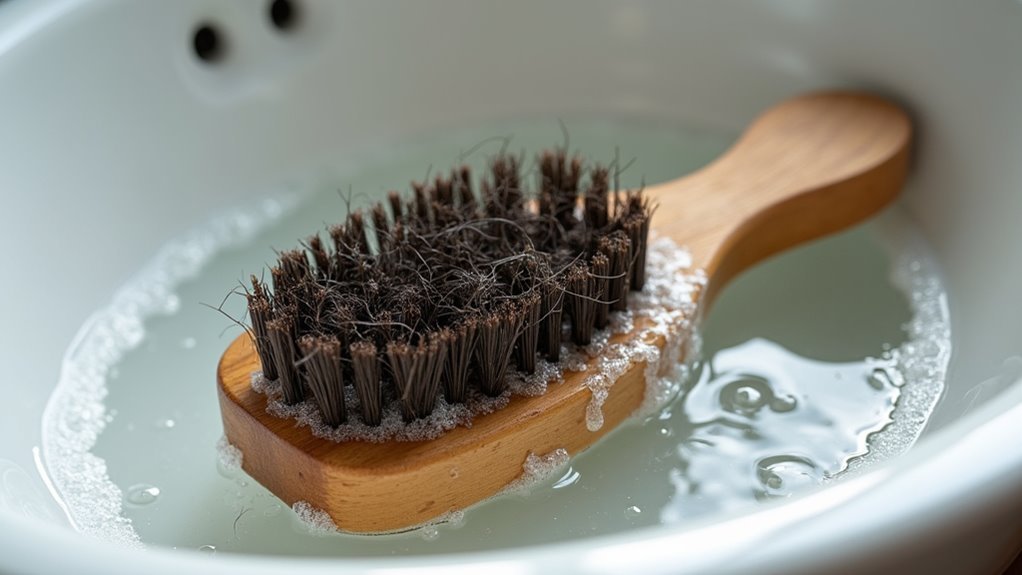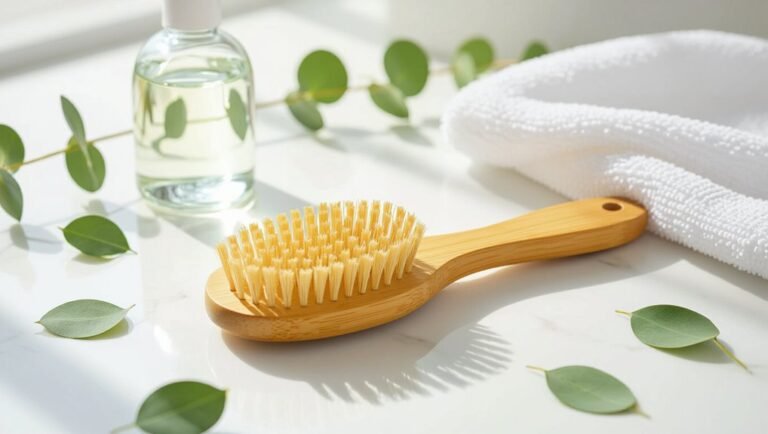A lot of people end up buying new beard brushes because their old ones get too dirty to use. But there’s no need to waste money – with some basic cleaning every few months, your beard brush can stay in great shape for years.
According to Eric Bandholz, founder of Beardbrand, “A clean beard brush not only works better but also keeps your facial hair healthier. Think of it like washing your hairbrush – you wouldn’t want to style your hair with a dirty brush.”
Just like you need to clean your bathroom and wash your clothes, your grooming tools need regular care too. When beard brushes get filled up with oils, dead skin, and loose hair, they stop working as well as they should. The good news is that cleaning them is pretty simple, and taking care of your brush means you won’t have to keep buying new ones.
Beard Brush Maintenance Essentials

Why do we often forget about cleaning the tools that keep our beards looking their best?
That beard brush collects everything – hair, skin flakes, product residue – and deserves regular attention, typically monthly or bi-monthly depending on how often you use it. Regular cleaning prevents buildup of oils and enhances the brush’s effectiveness, ensuring your beard stays healthy and well-groomed.
For proper maintenance, you’ll need a beard comb, beard shampoo, warm water, a toothbrush, and some beard oil for conditioning after cleaning.
##
We’re now going to look at what you should do and avoid when cleaning your beard brush with solvents, which can be really helpful for thorough maintenance.
I think most guys don’t realize that while regular soap cleaning works for daily use, occasionally you’ll need something stronger to break down stubborn oils and product buildup. Keeping your brush clean is essential for maintaining scalp health, as it helps to prevent buildup of product residue and dead skin cells.
Let’s walk through the proper steps for using solvents safely, what mistakes to avoid, and perhaps some final thoughts on making this part of your regular brush care routine.
Things to Do When Cleaning a Beard Brush
Cleaning your beard brush properly is essential for maintaining good beard hygiene and extending the life of your grooming tools.
A thorough cleaning removes accumulated hair, skin cells, product residue, and bacteria that can build up over time, preventing these contaminants from being reintroduced to your beard during future grooming sessions.
- Comb out debris – Use a beard comb to gently scrape across the bristles from base to tip, removing loose hairs and large particles without pressing too hard.
- Rinse with warm water – Run warm (not hot) water over the bristles to wash away loosened debris while being careful not to soak the wooden handle.
- Apply beard shampoo – Work a small amount of beard shampoo into the wet bristles, focusing on the base where oils and product residue tend to accumulate.
- Scrub with a toothbrush – Use an old toothbrush to thoroughly clean between bristles, removing stubborn residue.
- Rinse thoroughly – Make sure all shampoo is washed away to prevent sticky residue from forming.
- Deep clean crevices – Use a toothpick to carefully remove debris from tight spaces between bristles.
- Sanitize (optional) – Apply rubbing alcohol with a cotton swab to disinfect the brush if desired.
- Dry properly – Shake off excess water and place the brush bristles-down to air dry completely for at least 24 hours.
- Condition with oil – Apply a few drops of beard oil to the wooden handle and bristles once dry to maintain moisture and prevent cracking.
Things to Avoid When Cleaning a Beard Brush
Cleaning your beard brush properly is essential for maintaining both the brush’s longevity and your beard’s health.
Improper cleaning methods can damage the brush structure, compromise bristle integrity, or introduce harmful residues that transfer to your facial hair.
Understanding what practices to avoid will help guarantee your beard brush remains in ideal condition for as long as possible.
- Soaking in water – Wood handles can absorb water, causing swelling, warping, or cracking, particularly in non-lacquered brushes like ZilberHaar models.
- Using household soaps or regular shampoo – Dish soap, hand soap, and standard shampoo leave residues that damage bristles and can transfer harmful chemicals to your beard.
- Cleaning with hot water – Excessively hot water may warp or crack wooden handles; use warm (not boiling) water instead to preserve structural integrity.
- Aggressive bristle manipulation – Pressing too hard when combing or scraping bristles can dislodge them from the base, greatly shortening the brush’s 3-4 month typical lifespan.
- Using heat for drying – Hair dryers and other heat sources cause rapid moisture changes that can crack the wood; always air dry at room temperature for at least 24 hours.
Steps
Regular maintenance of your beard brush is essential for hygiene and prolonging the life of your grooming tool.
A clean brush not only performs better but also prevents the transfer of dirt, oil, and product buildup back onto your beard.
Following the proper cleaning process guarantees your brush remains in ideal condition while effectively removing accumulated debris, dead skin cells, and product residue that can compromise both the brush’s performance and your beard’s health.
Step 1: Comb through the bristles using a beard or mustache comb, dragging from base to tip to remove loose hair and debris without damaging the bristles.
Step 2: Rinse the brush under warm running water, focusing on the bristles while keeping the handle dry to prevent water damage to wooden handles.
Step 3: Apply beard shampoo to the bristles, then massage into the base and use a wet toothbrush to gently scrub between bristles.
Step 4: Rinse thoroughly multiple times until all shampoo residue is removed from the bristles.
Step 5: Use a toothpick to carefully remove stubborn debris from between bristles and crevices.
Step 6: Clean out remaining debris with a cotton swab, optionally disinfecting with rubbing alcohol.
Step 7: Shake off excess water and gently pat dry with a towel.
Step 8: Air-dry the brush bristles-down for at least 24 hours to guarantee complete drying.
Step 9: Apply a small amount of beard oil to both the wooden handle and bristles for protection and conditioning.
Final Thoughts
Maintaining your beard brush isn’t just a chore—it’s a worthwhile investment in your grooming routine.
Regular cleaning prevents buildup that might damage bristles and extends your brush’s life.
We think the 3-4 month replacement timeframe is perhaps a bit conservative for some users.
With proper care—cleaning monthly and applying protective oil—your brush could last longer, especially if you’re not using it daily.
##

Properly maintaining your beard brush isn’t just about cleanliness—it’s about preserving your investment in your grooming routine.
By establishing a regular cleaning schedule every other month, using the right techniques to remove debris, disinfecting when necessary, and allowing proper drying time, you’ll greatly extend your brush’s lifespan and maintain its effectiveness. Remember that even with excellent care, beard brushes with natural bristles will eventually wear down with daily use.
Regular maintenance isn’t just cleaning—it’s protecting your grooming investment and ensuring optimal beard care performance.
Plan to replace your brush every 3-4 months for best performance. This regular replacement guarantees you’re always getting the best distribution of oils and styling capabilities from your grooming tools. Additionally, proper brush care ensures that your grooming tools remain effective for future projects.
Take pride in your beard care routine by giving your tools the same attention you give your facial hair. A clean brush means a healthier beard, and a healthier beard means a more confident you. Start implementing these cleaning habits today—your beard will thank you.






